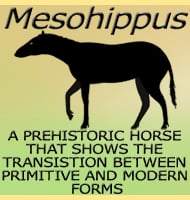In Depth
Barbourofelis is easily one of the largest of the ‘false sabre-toothed cats’ which were carnivorous mammals that through convergent evolution evolved to be very much like cats in form even though they are in fact quite distantly related. For this reason Barbourofelis is often quoted as being a member of the Nimravidae, a large group of false sabre toothed cats, although most palaeontologists place Barbourofelis within its own related but distinct group; the Barbourofelidae.
Barbourofelis was a powerfully built predator with a skeletal structure that is indicative of a strongly developed musculature similar in scale to the much later and true sabre-toothed cat Smilodon populator. This hints that like Smilodon populator, Barbourofelis was very physical in its attacks upon animals, subduing them with brute strength before using its enlarged sabre like upper canines to deliver a killing bite. The large size also hints at a specialisation in slower but more powerful prey like primitive rhinos that would have been very common in North America during the Miocene.
Barbourofelis was not the only false sabre-toothed cat in North America, although the other earlier forms such as nimravids like Nimravus and Hoplophoneus were much smaller. The main predatory competition for Barbourofelis would have been bear dogs like Amphicyon that were also very large and powerful predators. However niether Barbourofelis nor Amphicyon lived beyond the Miocene, and it’s thought that a combination of climate change yielding new herbivores and new more advanced predators to hunt them displaced these two powerful animals as top predators, with extinction soon following.
Further Reading
– Bulletin of the Nebraska State Museum 9(1). – C. B. Schultz et al – 1970. – Barbourofelis (Nimravidae) and Nimravides (Felidae), with a Description of Two New Species from the Late Miocene of Florida. – Journal of Mammalogy 62(1):122-139. – J. A. baskin – 1981.









